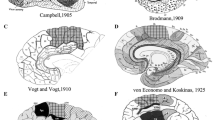Abstract
In this study we analyzed structural and functional aspects of the human primary somatosensory areas 3a, 3b, and 1 on the basis of a computerized brain atlas. The approach overcomes many of the problems associated with subjective architectonic parcellations of the cortex and with ”classical” brain maps published in a ”rigid” print format. Magnetic resonance (MR) scans were obtained from ten postmortem brains. The brains were serially sectioned at 20 µm, and sections were stained for cell bodies. Areas 3a, 3b, and 1 were delineated statistically on the basis of differences in the laminar densities of neuronal cell bodies. The borders of the areas were topographically variable across different brains and did not match macroanatomical landmarks of the postcentral gyrus. After correction of the sections for deformations due to histological processing, each brain’s 3-D reconstructed histological volume and the volume representations of areas 3a, 3b, and 1 were adapted to the reference brain of a computerized atlas and superimposed in 3-D space. For each area, a population map was generated that described, for each voxel, how many brains had a representation of that area. Despite considerable interindividual variability, representations of areas 3a, 3b, and 1 in ≥50% of the brains were found in the fundus of the central sulcus, in the rostral bank, and on the crown of the postcentral gyrus, respectively. For each area, a volume of interest (VOI) was defined that encompassed that area’s representation in ≥50% of the brains. Despite close spatial relationship in the postcentral gyrus, the three VOIs overlapped by <1% of their volumes. Changes in regional cerebral blood flow (rCBF) were measured with positron emission tomography when six right-handed subjects discriminated differences in the speed of a rotating brush stimulating the palmar surface of the right hand. With co-registered MR images, the rCBF data were adapted to the same reference brain and superimposed with the microstructural VOIs. Discrimination of moving stimuli, contrasted to rest, increased the rCBF in the VOIs of areas 3b and 1, but not in area 3a. This approach opens up the possibility of (1) defining VOIs of cortical areas which are not based on macroanatomical landmarks but instead on observer-independent cytoarchitectonic mapping of postmortem brains and of (2) determining in these VOIs changes in rCBF data obtained from functional imaging experiments.
Similar content being viewed by others
Author information
Authors and Affiliations
Additional information
Accepted: 9 May 2001
Rights and permissions
About this article
Cite this article
Geyer, S., Schleicher, A., Schormann, T. et al. Integration of microstructural and functional aspects of human somatosensory areas 3a, 3b, and 1 on the basis of a computerized brain atlas. Anat Embryol 204, 351–366 (2001). https://doi.org/10.1007/s004290100200
Issue Date:
DOI: https://doi.org/10.1007/s004290100200




